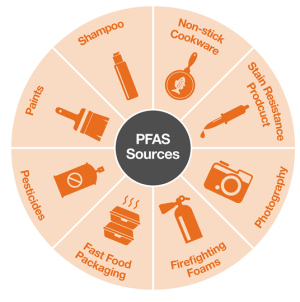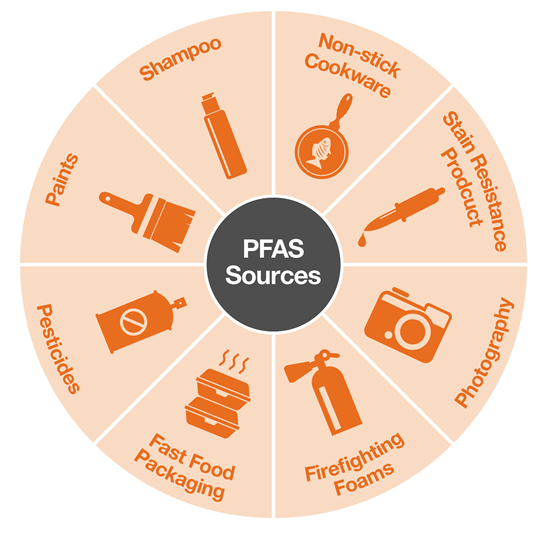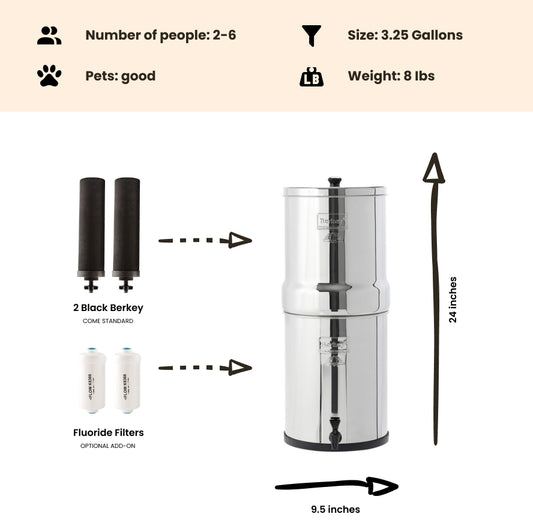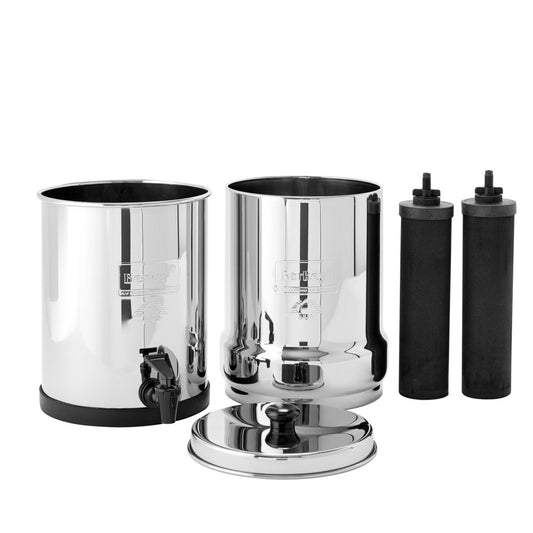
What are PFAS Chemicals? Does the Berkey Remove PFOA and PFOS; and other FAQs?
By Dan DeBaunShare
Want to know what's the difference between PFAS, PFOA and PFOS chemicals, and whether Berkey water filters can remove them? We answer some FAQs below.
Do Berkey Water Filters Remove PFAS?
The short answer is Yes! PFAS's fall under the category of PFC's - Perfluorinated Chemicals. PFOA, PFOS, etc. The Black Berkey elements that come standard with our Berkey water do remove these contaminants by over 99.9%. Berkey water filter PFOA test results can be found here.
What is PFAS?
PFAS is an acronym for perfluoroalkyl and polyfluoroalkyl substances — a group of synthetic chemicals that are used to manufacture hundreds of common household and industrial products, including non-stick cookware (e.g. Teflon), food packaging, water- and stain-resistant fabrics and products (e.g. Scotchguard), wax, polish, paint, and fire-fighting foam — an important source of PFAS contamination of groundwater at military bases and airports where fire-fighting training takes place.
What are PFOS and PFOA?
PFOS and PFOA are two of the most prolific chemicals belonging to the PFAS group of chemicals which have been produced in the United States and other countries around the world since the 1940s.
Are PFOA and PFOS the same thing? What is the difference between PFOS and PFOA?
While PFOA and PFOS are both C8 fluorinated organic compounds (i.e. they have 8 carbon molecules in their structure) belonging to the PFAS group of chemicals, they are two distinct chemical substances, namely: perfluorooctanoic acid (PFOA) and perfluorooctane sulfonate (PFOS). Both are resistant to water and lipids, which although beneficial in the products they are used in, means they do not readily break down, but rather persist in the environment and in the bodies of animals, including humans, that are exposed to them.
Where are PFOA and PFOS found? What are the main routes of exposure?
Americans may be exposed to PFOA, PFOS and other PFAS chemicals through various pathways. While exposure through drinking water is an area of great concern, we can also be exposed to these chemicals via the food we eat, as well as food packaging and a wide range of household products that contain these chemicals; even household dust and airborne fumes containing PFAS. Exposure via the foods we eat could also be a key source of exposure, especially considering that these chemicals persist in animals such as fish, and accumulate in body tissue over time. Drinking water contaminated with PFOA and PFOS is considered a significant source of exposure, and one that can be regulated to reduce the levels of exposure. According to the EWG, drinking water standards for PFOA and PFOS should also take ongoing exposure to these harmful chemicals from the food we consume and other sources into account.
How does PFAS get in water?
PFAS chemicals can get into water sources via several different pathways. Fire-fighting foam used in training exercises at military bases and airports has been responsible for legacy contamination of soils and groundwater near these sites. As mentioned earlier, they don't break down once they are in the environment, but tend to persist. Consequently, even though the use of these chemicals has being banned or systematically phased out, it is highly likely that groundwater will continue to be contaminated for many years to come.
PFAS can also be transported in airborne dust particles released from factory chimney stacks and contaminated sludge dumped at landfills, as was the case with DuPont, the manufacturers of Teflon, who were held responsible for polluting the local water supply of Parkersburg, West Virginia. This transgression led to the company being sued by factory workers, affected local residents, and communities living downstream who claimed to have suffered health issues resulting from exposure to these hazardous contaminants. DuPont eventually agreed on a US$671 million settlement with the 3,500 affected residents of West Virginia and Ohio. However, the list of litigants filing lawsuits agains DuPont, 3M and other companies responsible for PFAS contamination has since expanded to include New York, New Jersey and New Hampshire.

Sailors aboard the aircraft carrier USS Ronald Reagan (CVN 76) sweep the deck during the Aqueous Film Forming Foam (AFFF) firefighting system test. This firefighting foam is a PFAS.
How widespread is PFAS contamination?
Nationwide testing of drinking water supplies for six PFAS chemicals by the Environmental Working Group (EWG) in collaboration with scientists from the Northeastern University in Massachusetts uncovered more than 700 sites across 49 states where drinking water serving more than 16 million Americans is contaminated with PFAS chemicals (see EWG's PFAS Contamination Map). However, the EWG estimates that the number of consumers exposed to PFAS in drinking water could be as high as 110 million people.
Are PFOA's toxic? How does PFOA affect human health?
Studies have shown that exposure to PFOA and PFOS is associated with an increase in cholesterol levels, as well as negative effects on the immune system, low infant birth weights, disruption of the thyroid hormone (PFOS), and an increase risk of cancer (PFOA). Studies conducted on animals show that PFOS and PFOA can negatively effect reproduction and development, and have a negative effect on the liver, kidneys and immune system. Exposure to both PFOA and PFOS also increased the risk of tumors in animals.
According to the EWG, the entire group of synthetic PFAS chemicals (consisting of more than 3000 chemicals in all) poses an issue of concern, because even low levels of exposure to some chemicals in this group can pose serious health risks, including disruption of the endocrine and immune systems, promoting liver damage and thyroid changes, and increasing the risk of cancer.
How long do PFAS stay in your system?
Once PFAS chemicals enter the body, they do not break down, but rather tend to persist unchanged for a very long time. Once ingested, levels of the two most common PFAS chemicals, PFOS and PFOA, will only drop by half after about 4 years if no more are ingested. If you are continually ingesting PFAS, these contaminants will bioaccumulate in your body tissue, where they can potentially wreak havoc with your health.
How Much PFOA and PFOS is Safe in Drinking Water?
Depends who you ask. The EPA has posted a health advisory recommending PFOA and PFOS levels for drinking water at 70 parts per trillion, which according to them, will "provide Americans, including the most sensitive populations, with a margin of protection from a lifetime of exposure to PFOA and PFOS from drinking water." However, the Environmental Working Group, who holds the opinion that there is no safe level of PFAS in drinking water, takes a much more cautious approach, recommending a maximum of 1 part per trillion (ppt), or 0.001 parts per billion (ppb) – for each PFAS chemical detected in drinking water if we wish to fully protect our children's health and that of other vulnerable populations within our families and communities. The EWG's proposed health guidelines for PFOA and PFOS — the two most widespread and well studied chemicals in the PFAS group— in drinking water are 70 times lower than those set by the EPA. Which effectively means that drinking water supplies may be contaminated with harmful levels of PFAS chemicals and nothing is being done about it, placing you and your loved ones at risk. Unless, of course you take your own measures to reduce levels of PFOA and PFOS in your drinking water.
Does boiling water remove PFAS?
Since PFAS chemicals are water resistant they do not break down in water. Boiling the water doesn't kill them either. If your water is contaminated with PFAS, boiling will not remove them. However, the good news is that there are other ways and means of reducing the levels of PFAS in water significantly.
Do water filters remove PFOA?
PFOA and PFOS tend to be resistant to conventional microbial and chemical water treatment technologies, which are ineffective at removing them during the treatment process. The most effective technologies that have been independently tested and proven capable of removing PFAS from drinking water include reverse osmosis (RO), ion exchange, and activated carbon absorption technologies. Granular activated carbon is another efficient and cost effective method of removing PFOA, PFOS and other harmful PFAS chemicals that can be used by both water utility's and the consumer to remove PFAS contaminants from their drinking water supply.
How do you remove PFOA and PFOS from water at home?
Nanofiltration technologies and reverse osmosis systems have proven to be very efficient at removing PFAS from drinking water. To ensure your drinking water is safe, you can filter your water with a reverse osmosis system or an activated carbon water filtration system, such as the Berkey range of home water filters, to reduce or remove PFOA, PFOS and other harmful PFAS chemicals. The Black Berkey filter cartridges are capable of removing more than 99.9% of PFOS, PFOA and other harmful PFAS.
How do you reduce your exposure to PFAS?
Since many household products contain harmful PFAS chemicals, exposure is not limited to contaminated drinking water, but can occur through contact with everyday items such food packaging and even food. The EWG recommends limiting exposure to fast-food wrappings (typically coated with PFAS) by preparing home-cooked meals instead, and steering away from microwave popcorn, paper plates and other everyday products that are laden with PFAS. The EWG's guide offers more tips on how to avoid PFAS.
How safe are replacement PFAS chemicals?
While scientists tend to agree that all chemicals in the PFAS group pose a human health risk, there is growing concern regarding the safety of the chemicals being used to replace PFOS, PFOA and other PFAS chemicals. A recent peer-reviewed scientific study has revealed that replacement chemicals, such as GenX which is used by DuPont instead of PFOA, may pose even more environmental and health risks than the chemicals they have replaced. Laboratory studies conducted on animals show that exposure to GenX, which is currently not regulated by the EPA or other state or government health agencies, is associated with an increased risk of cancer. More studies on the health effects associated with long-term exposure to GenX are needed.
Can the Black Berkey filter cartridges remove GenX?
GenX, the chemical touted as a more benign replacement of the more toxic PFOA used in the manufacture of household products such as non-stick cookware, water resistant fabrics and fire-fighting foam. GenX recently contaminated drinking water supplies of the Cape Fear Public Utility Authority in North Carolina after a plant that produces the chemical is suspected of discharging it into the environment.
Since the NMCL does not have actual testing for these particular contaminants in place yet, the effectiveness of Black Berkey Purification elements at removing GenX has not been tested. However, considering GenX's similarity to PFOA , and that the Black Berkey has been tested and proven to remove PFOA, PFOS and other organic compounds by 99.9% or more and capable of reducing perfluorinated chemicals (PFCs) levels down to 2ppt (parts per trillion), the expectation is that the Black Berkey Purification elements would be effective at reducing GenX in drinking water. Until specific tests are available we cannot make a substantiated claim regarding this specific chemical.
The Berkey water filters offer a simple, portable and cost effective way of reducing your exposure to PFOA, PFOS, and a wide range of other harmful chemicals and contaminants that could adversely affect your health.
-
Regular price $234.00 USDRegular priceUnit price / per
-
Regular price $327.00 USDRegular priceUnit price / per
-
Regular price From $367.00 USDRegular priceUnit price / per
-
Regular price From $408.00 USDRegular priceUnit price / per
-
Regular price From $451.00 USDRegular priceUnit price / per
-
Regular price From $478.00 USDRegular priceUnit price / per
-
Regular price $332.50 USDRegular priceUnit price / per
$350.00 USDSale price $332.50 USDSale

Dan DeBaun
Dan DeBaun is the owner and operator of Big Berkey Water Filters. Prior to Berkey, Dan was an asset manager for a major telecommunications company. He graduated from Rutgers with an undergraduate degree in industrial engineering, followed by an MBA in finance from Rutgers as well. Dan enjoys biohacking, exercising, meditation, beach life, and spending time with family and friends.
~ The Owner of Big Berkey Water Filters


















Would appreciate to know if and when a test can be done on the new GenX chemical can be done or will be done?
Peer reviewed research suggests that Berkey is not particularly effective at removing GenX. GenX is not a long chain PFAS chemical so this may be part of the reason, it is actually smaller than PFOA, n fact it is a byprodcut of the PFOA process.
Herkert, Nicholas J., John Merrill, Cara Peters, David Bollinger, Sharon Zhang, Kate Hoffman, P. Lee Ferguson, Detlef R. U, Knappe and Heather Stapleton. (2020). Assessing the Effectiveness of Point-of-Use Residential Drinking Water Filters for Perfluoralkyl Substances (PFAS). Environmental Science and Technology Letters. 7(3): 178-184.
Hi Regina -
Thank you for your comment This study only tested one countertop filter and there's dozens on the market. It did not list the brand they tested, so we would not assumed it's a Berkey. Different countertop systems employ different media formulas, so one countertop system not performing well, doesn't mean another will not. With that being said, until tests are done on the Berkey regarding GenX removal, we would not recommend the Berkey for it's removal.
Thanks
Dan
Hi Dan! Its been years since I have had the opportunity to speak directly with you as you became so busy and I did all my ordering through Sue, and now she has retired. I bought my first Berkey, oh my goodness it had to have been around 2002 or there about, and have since bought two more for family plus the travel one to carry in the semi. They are all doing as intended and I am so glad we have them. I have just recently retired off the road after 25 years long haul and am healing from a right knee replacement, scheduled for a left hip replacement and etc.. things one seems to need as age creeps up on us. All my best to you and the crew.
Sincerely,
Anita
Hi Anita!!
So glad to hear you and I'm happy the systems are working well for you and your family. And I also glad you finally retired. More time to focus on getting your health back in tip-top form! Enjoy your retirement and live in the moment Anita! If you ever need anything, ask for Jennie. She replaced Sue/Ann.
Thanks
Dan